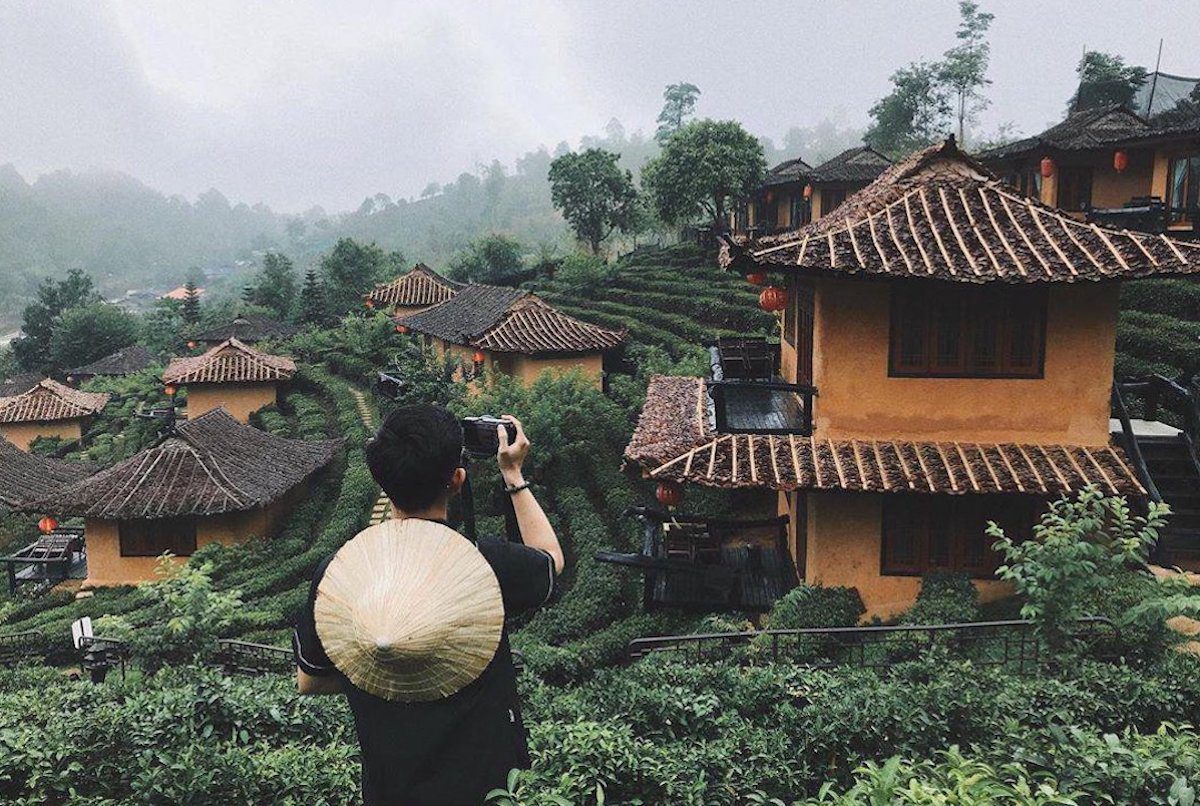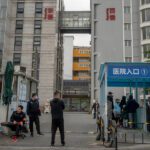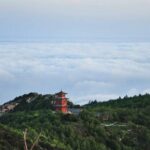Global Courant 2023-05-08 11:13:22
BAN RAK THAI – Decaying guns, faded battlefield photos, and crudely sketched jungle maps of defeated, anti-Communist, US-equipped Chinese Kuomintang (KMT) guerrillas are cherished in this northern frontier village.
The KMT and China stopped killing each other decades ago. Today, the descendants of the KMT graciously serve pleasure-seeking Chinese tourists by lodging them in cozy Chinese-themed hotels and spoiling them with locally grown, fermented oolong tea.
KMT families are thankful that their victorious former enemy is boosting their local economy. The traumatic reversals of fortune on both sides show how China’s monetized soft power is affecting this Southeast Asian nation.
“Some Chinese people come here and see these things, and say they regret the way the KMT was treated so harshly years ago,” said Wang Ja Da, gesturing at his thatched-roof restaurant where the rusty, dilapidated machine of his family could be seen. rifle alongside metal helmets, canteens, boxes of ammunition cartridges, and other KMT equipment.
The dusty display is littered with pictures of armed, uniformed KMT that did not survive.
“Because of China’s soft power, some KMT Chinese in northern Thailand have gradually shifted their stance from pro-Taipei to pro-Beijing,” said ThinkChina, a Singapore-based English-language news site.
China’s soft power shows up in other subtle ways.
Many ethnic Chinese-Thai parents – and some non-Chinese Thai – send their children to private Chinese language schools for the first four years to learn Mandarin, preparing them for possible careers with Chinese investors, government officials and others.
Dozens of Chinese government-funded Confucius Institutes (CIs) operate in Thailand, sponsored worldwide by China’s National Office for Teaching Chinese as a Foreign Language.
They are open to the public, promote Chinese language, culture and festivals, and teach locals to become teachers.
CI classes for Thai officials included “Anti-Corruption Bureau Chinese Lesson,” “Immigration Bureau Chinese Lesson,” “Parliament Chinese Lesson,” and “Advanced Chinese Lessons for Government Officials,” according to a report titled “Confucius Institute in Sino-Thai relations: a display of China’s soft power’, by Singapore’s National University.
“The introduction of CIs allows some Thai companies to find a reliable intermediary to facilitate trade with Chinese companies.
“These programs received the support of the Thai government, the Thai royal family and local business people because they equate CIs with a strategic and economic tool,” said the report from the university’s sociology department.
China-based 5G telecommunications from Huawei is also making inroads in Thailand, welcomed by the government of Thai Prime Minister Prayut Chan-ocha.
In Bangkok, meanwhile, a new generation of Chinese immigrants has arrived by land from Yunnan, Sichuan and other landlocked provinces.
These so-called “overland Chinese” or “overland Yunnanese” are a different ethnic trend compared to previous centuries when most Chinese arrived in what was then Siam by sea from the southeast coast of China.
Many Thai ancestors left China during those centuries of trade and disaster, creating politically and commercially successful Sino-Thai families.
Those settlers also created Bangkok’s Chinatown along the Chao Phraya River 200 years ago, building “go-down” warehouses and “shophouses” for international import and export.
Thailand depended on its ethnic Chinese entrepreneurs to help the country’s economy survive international financial upheavals, especially in the 20th century.
Today, Chinatown’s expensive real estate and maze of densely populated neighborhoods with lots of tourists are more expensive than many newcomers.
Newcomers are instead creating a “new Chinatown,” they hope, along the non-descript two-lane Pracha Rat Bamphen Road.
These backstreets in Bangkok’s Huai Khwang district offer Yunnan and Sichuan cuisine – hard to find among Chinatown’s mostly Teochew, Hokkien, Hakka and Cantonese restaurants.
Arriving Chinese immigrants and tourists are also drawn to the neighborhood’s cheaper hotels, apartments, and offices, allowing them to conduct business, intermarry, and study—conveniently located near the Chinese embassy.
Another form of Beijing’s soft power is through the government-controlled People’s Daily media supplements, which occasionally appear in the English-language Bangkok Post and inevitably coo about China’s benevolent, practical, peaceful, high-tech and profitable plans and policies.
Amid the ongoing, often short-lived, soft power and propaganda, the Pentagon worries which side Thailand – a war-tested ally – will support if war breaks out between the US and China in the region over Taiwan or the South China Sea.
Bangkok is trying to project a neutral stance between the two countries, hoping to benefit all parties, and maintains close relations with both.
Meanwhile, not all soft power works in favor of China or the US.
“The two aspects of soft power that immediately come to mind relate to American products and Chinese tourists,” says Benjamin Zawacki, Bangkok-based American author of “Thailand: Shifting Ground Between the US and a Rising China.”
Chinese tourists watch a traditional Thai dance at Erawan Shrine, a popular spiritual landmark in Bangkok, on January 27, 2020. Photo: AFP/Mladen Antonov
“But while Thais consume predominantly American products – Starbucks coffee, Facebook, Marvel movies, Nike sneakers, Taylor Swift – and criticize Chinese tourists as disorderly, it is hardly clear that this reflects the opinion of the Thai public or elite about the US increases or decreases. it’s about China,” Zawacki said in an interview.
Neither does history. When Chinese communist leader Mao Zedong won victory in 1949, most of the anti-communist KMT fled to Taiwan, led by General Chiang Kai-shek and his seductive, English-speaking wife who courted Washington to fund his Kuomintang National People’s Party.
Washington also supported a captured KMT “Lost Army” made up of stragglers from the 93rd Division retreating southwest across the border into Myanmar (then known as Burma) near the border with Thailand.
From makeshift KMT bases in Myanmar, the rebels launched futile cross-border raids into southern China’s Yunnan province in 1949-1961, aided by the Central Intelligence Agency (CIA).
“This radio belongs to the Americans,” Mr. Ja Da said, pointing to a green rectangle of cloth-covered, dial-studded antique technology.
“My father was a KMT fighter. I was too young, so I was a radio messenger, running on foot from radio towers to wherever the KMT was, to deliver the messages,” he said, because the KMT didn’t have enough portable “military cordless phones.”
In 1950, Thailand’s then chief of police, Police General Phao Siyanon, “allowed CIA planes to refuel in Thailand and personally transported the first shipment of weapons to the (KMT) Nationalists in Burma, bordering Yunnan,” Zawacki wrote in his book.
“Three invasions were attempted until August 1951.” In 1956, “Thailand also accused the Nationalists—still assisted by the CIA—of obtaining arms and funds illegally,” Zawacki wrote.
Part of the KMT smuggled opium juice from Shan State in Myanmar, the heart of the drug-rich Golden Triangle where the porous borders of Thailand, Myanmar and Laos converge.
Armed KMT mule convoys guarding heavy sacks of opium – strapped to saddles of wood, leather and canvas – slid into the Golden Triangle section of northwestern Thailand.
China convinced Myanmar to jointly expel the KMT.
So the rebels and their families fled here to Ban Rak Thai – less than a mile from Myanmar – and other northern Thai mountain villages in the 1950s and early 1960s.
Opium smuggling continued and poppy cultivation spread in the steep mountains of the Golden Triangle portion of northwestern Thailand. Eventually, Thai officials ordered the estimated 200 KMT families to grow tea and other cool-climate legal crops.
In return, Thailand allowed the KMT to settle, initially to protect the region from alleged members of the Communist Party of Thailand and subversive minority ethnic tribes in the 1960s and 1970s.
Today, the Thai tourism industry touts the 1,800-foot Ban Rak Thai as a nostalgic echo of the KMT’s long-lost province of Yunnan.
An estimated 200,000 Chinese of Yunnan descent now live in northern Thailand. Image: Facebook
Tourists from Beijing, Shanghai and elsewhere marvel at the quaint faux vintage stone architecture themed around an adorable depiction of Yunnan’s traditional villages.
KMT families also own plantations around Ban Rak Thai, supplying ubiquitous tea stalls.
An estimated 200,000 Chinese of Yunnan ancestry now live in more than 100 villages across the northern provinces of Chiang Rai and Chiang Mai, plus here in Mae Hong Son province.
Richard S Ehrlich is a Bangkok-based American foreign correspondent who has been reporting from Asia since 1978. Excerpts from his two new non-fiction books, “Rituals. killers. Wars. & Sex. — Tibet, India, Nepal, Laos, Vietnam, Afghanistan, Sri Lanka & New York” and “Apocalyptic Tribes, Smugglers & Freaks” are available here.
Similar:
Loading…




